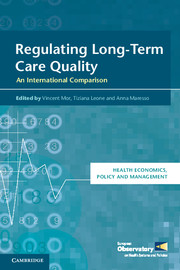Book contents
- Frontmatter
- Contents
- List of Tables, figures and boxes
- List of Contributors
- Foreword
- Part I Introduction
- Part II Long-term care quality systems based on ‘professionalism’
- 2 Performance measurement in long-term care in Austria
- 3 Monitoring the quality of long-term care in Germany
- 4 Quality monitoring and long-term care in Switzerland
- 5 Japan’s long-term care regulations focused on structure – rationale and future prospects
- Part III Long-term care quality systems based on regulatory inspection frameworks
- Part IV Long-term care quality systems based on data measurement and public reporting
- Part V Long-term care quality systems and developing regulatory systems
- Part VI Conclusion
- Index
- References
2 - Performance measurement in long-term care in Austria
Published online by Cambridge University Press: 05 February 2014
- Frontmatter
- Contents
- List of Tables, figures and boxes
- List of Contributors
- Foreword
- Part I Introduction
- Part II Long-term care quality systems based on ‘professionalism’
- 2 Performance measurement in long-term care in Austria
- 3 Monitoring the quality of long-term care in Germany
- 4 Quality monitoring and long-term care in Switzerland
- 5 Japan’s long-term care regulations focused on structure – rationale and future prospects
- Part III Long-term care quality systems based on regulatory inspection frameworks
- Part IV Long-term care quality systems based on data measurement and public reporting
- Part V Long-term care quality systems and developing regulatory systems
- Part VI Conclusion
- Index
- References
Summary
The emerging Austrian long-term care system in the context of a federal constitution
In Austria, long-term care started to become acknowledged as a specific field of social and health policies during the 1980s, when a debate about long-term care allowances was initiated by people with disabilities acquired during their working age. The ensuing reform was marked by the legacies of the traditional Austrian welfare regime, by the federal constitution and the clear-cut distinction between the health and social care systems. The decentralized governance of health and social care in Austria has been based on two distinct principles. On the one hand, healthcare is a part of the social insurance system that is primarily regulated by the federal government, financed by contributions and administered by the self-governed health insurance agencies at federal and regional levels. The regional governments (Bundesländer) are involved as planners, managers and co-financers of hospitals (Hofmarcher and Quentin, 2013). On the other hand, the principle of subsidiarity has been applied to the areas of disability, social and long-term care with respective responsibilities assigned by constitutional law to the nine regional governments. Their activities are funded from general taxes that are centrally levied and distributed according to defined criteria. In practice, this means that, if patients have been assessed as being in need of long-term care, they have to rely on their own assets and/or means-tested social assistance from the local or regional authorities (Ganner, 2008).
- Type
- Chapter
- Information
- Regulating Long-Term Care QualityAn International Comparison, pp. 33 - 66Publisher: Cambridge University PressPrint publication year: 2014
References
- 2
- Cited by

